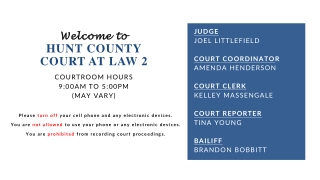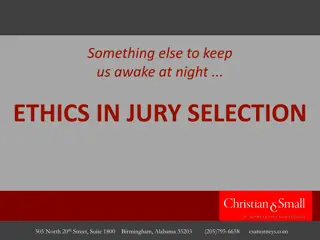Mastering Voir Dire: Essential Tips for Jury Selection
Learn important insights on conducting effective voir dire examinations in legal proceedings, including identifying biased jurors and de-selecting the jury. Discover crucial strategies, such as knowing local rules, seeking counsel experience, and emphasizing the significance of the initial juror impression. Gain valuable wisdom on navigating the voir dire process professionally and optimizing jury selection outcomes.
Uploaded on Aug 04, 2024 | 11 Views
Download Presentation

Please find below an Image/Link to download the presentation.
The content on the website is provided AS IS for your information and personal use only. It may not be sold, licensed, or shared on other websites without obtaining consent from the author.If you encounter any issues during the download, it is possible that the publisher has removed the file from their server.
You are allowed to download the files provided on this website for personal or commercial use, subject to the condition that they are used lawfully. All files are the property of their respective owners.
The content on the website is provided AS IS for your information and personal use only. It may not be sold, licensed, or shared on other websites without obtaining consent from the author.
E N D
Presentation Transcript
Attorney Voir Dire: Careful What You Ask For Hon. Laurel Beeler, US District Court, Northern Dist. of California Khaldoun Baghdadi, Esq., Walkup Melodia Kelly & Schoenberger Asim Bhansali, Esq., Kwun Bhansali Lazarus
The Rules A juror is actually biased where the juror's answers in voir dire indicated that he or she cannot decide the case impartially. United States v. Gonzalez, 214 F.3d 1109, 1112 (9th Cir. 2000).
The Rules Actual bias is typically found when a prospective juror states that he can not be impartial or expresses a view adverse to one party's position and responds equivocally as to whether he could be fair and impartial despite that view. Fields v. Brown 503 F.3d 755, 767 (9th Cir. 2007).
The Rules The principal purpose of voir dire is to probe each prospective juror's state of mind to enable the trial judge to determine actual bias and to allow counsel to assess suspected bias or prejudice. Thus, a voir dire examination must be conducted in a manner that allows the parties to effectively and intelligently exercise their right to peremptory challenges and challenges for cause. Darbin v. Nourse, 664 F.2d 1109, 1112 1113 (9th Cir. 1981).
Some Wisdom 1. Know your Local Rules - and you cannot get local enough. 2. Contact counsel with experience in that courtroom. 3. Ask for permission, not forgiveness.
Your Goal in Voir Dire: De-Select Your Jury
Some Additional Wisdom 1. You only get one first impression 2. This is not about you. It never was. 3. You are not trying to win your case. There s a whole trial for that. 4. Don t waste time.
You only get one first impression This is the only time you get to speak with jurors, as opposed to at jurors. They will see things that you never imagined would matter. Be kind, courteous and genuinely sincere.
Its not about you Your job is to hear from the jurors. Not impress them. Jurors do not speak in causes of action. Jurors are likely more nervous than you are.
This is not the time to win your case Your goal is to uncover bias. Not to convince the whole room that your client wins. Do not make the Judge regret giving you this opportunity.
Do Not Waste Time Watch the clock. Have a plan, do your best, then sit down. Make this a panel discussion.
Attorney Voir Dire: Some examples.























